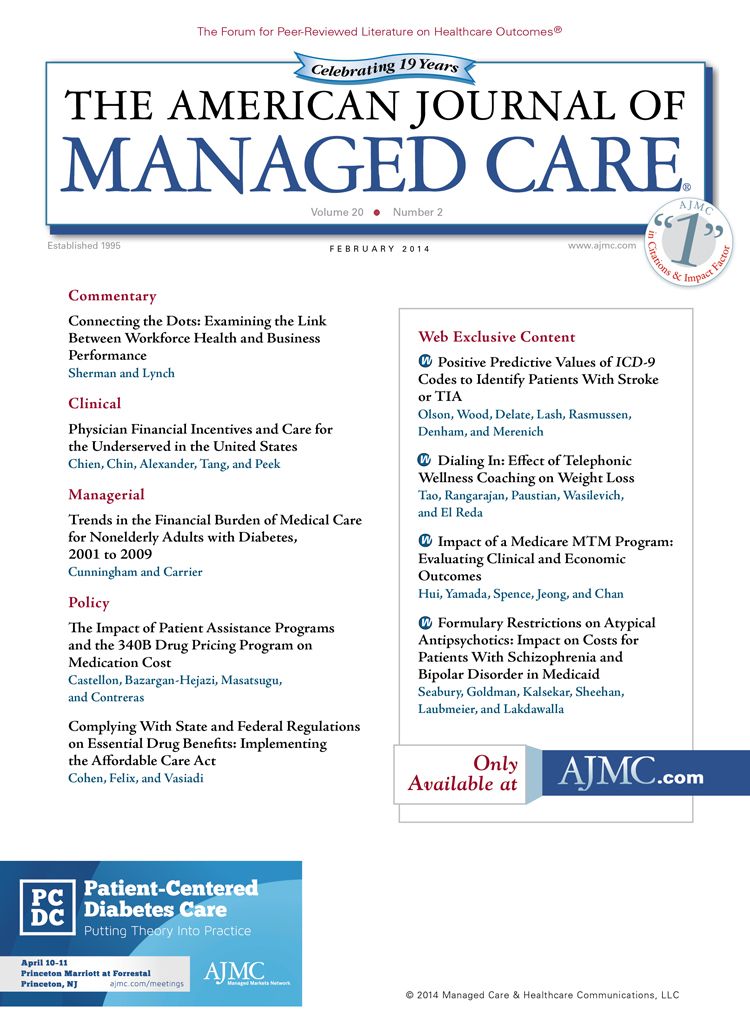Publication
Article
The American Journal of Managed Care
Patient Attitudes About Specialty Follow-up Care by Telephone
Author(s):
"This study describes positive patient attitudes toward the concept of telephone-based alternatives to specialty clinic follow-up.”
- Patients have positive attitudes toward using telephone-based follow-up in the specialty clinic setting.
- Using telephone-based follow-up may be an effective strategy to reduce discretionary follow-up visits and increase access to specialty care.
TO THE EDITORS:
The number of specialty care visits in the United States is rising, contributing to increased costs and delayed access to specialty care.1 In primary care, telephone-based follow-up has decreased the number of outpatient visits.2 However, telephone-based follow-up in specialty care has focused on clinical outcomes and quality of life, not on reduction of outpatient healthcare utilization.3
Little is known about patient attitudes toward using telephone-based programs to reduce office visits in US medical specialty clinics. In the context of a clinical operations project aimed at reducing discretionary specialty follow-up visits, we explored patient attitudes about telephone-based follow-up.
METHODS
We conducted semi-structured patient interviews over 2 months in an urban academic endocrinology clinic. Interviews were conducted in clinic with a convenience sample of patients immediately following their physician encounter.
Interviews started with questions on clinic experience and utilization followed by a description of a potential pilot program. The proposed program involved changing the type of scheduled follow-up for patients. Rather than scheduling a follow-up office visit at the end of the visit, an appointment for a telephone visit with the medical assistant (MA) would be scheduled. Information gathered during the MA telephone call would be conveyed to the physician, who would decide whether patients should have another telephone call by a health professional (MA or physician) or a scheduled physician office visit. Interviewers asked about patient attitudes toward the program. Participants were provided free parking as compensation.
Interview notes were iteratively reviewed individually by 5 evaluation team members, who then met and reached consensus on key findings and themes. This project did not meet criteria for review by the Internal Review Board, as it used existing data collected for a quality improvement project.
RESULTS
Table
Team members interviewed 24 patients (71% female, aged 22 to 64 years, median age 44.5 years). Overall, patients were very satisfied with their clinic experiences and traveled a median of 1.5 hours one way to clinic visits. Patients expressed enthusiasm for alternatives to office-based follow-up. The major themes that emerged were patient convenience, communication facilitation, and altruism (). Patient endorsement of telephone-based follow-up was predicated upon the expectation that physicians continue to have primary responsibility for clinical care. Two patients expressed reservations about MA phone followup, including concerns about MD-MA coordination.
COMMENT
This study describes positive patient attitudes towards the concept of telephone-based alternatives to specialty clinic follow-up. Unexpected findings include perceptions about the program’s potential to facilitate clinic communication and improve clinic access for others.
Previous studies have shown positive patient attitudes toward telephone-based alternatives to primary care clinic follow-up,2,4 and this study extends those findings to specialty clinic follow-up. New models of specialty care are needed to address patient and payer demands for better access and quality. These findings support pilot testing a program to introduce telephone follow-up visits as a strategy for reducing discretionary office visits and improving specialty care access in similar clinics. Further assessment of patient and provider attitudes about telephone-based follow-up care in other clinical settings and specialties is also warranted.Author Affiliations: San Francisco Veterans Affairs Medical Center, San Francisco, CA (JAE); University of California, San Francisco, School of Medicine, Division of Geriatrics (JAE); University of California, San Francisco, School of Medicine, Division of General Internal Medicine (CJH, MAH); University of California, San Francisco, School of Medicine, Department of Biostatistics and Epidemiology (MAH, CKB, RG); University of California, San Francisco, School of Nursing, Department of Social and Behavioral Sciences (SLA).
Funding Source: This project was supported by the National Center for Advancing Translational Sciences, National Institutes of Health, through UCSF-CTSI Grant Number UL1 TR000004. Its contents are solely the responsibility of the authors and do not necessarily represent the official views of the NIH.
Author Disclosures: The authors (JAE, CJH, MAH, CKB, RG, SLA) report no relationship or financial interest with any entity that would pose a conflict of interest with the subject matter of this article.
Authorship Information: Concept and design (JAE, CJH, MAH, CKB, RG, SLA); acquisition of data (JAE, CJH, CKB); analysis and interpretation of data (JAE, CJH, MAH, RG, SLA); drafting of the manuscript (JAE, MAH, CKB, RG, SLA); critical revision of the manuscript for important intellectual content (JAE, MAH, SLA); administrative, technical, or logistical support (CJH). Address correspondence to: Jessica A. Eng, MD, San Francisco VA Medical Center, 4150 Clement St, 181G, San Francisco, CA 94121. E-mail: jessica. eng@ucsf.edu.1. Mehrotra A, Forrest CB, Lin CY. Dropping the baton: specialty referrals in the United States. Milbank Q. 2011;89(1):39-68.
2. Wasson J, Gaudette C, Whaley F, Sauvigne A, Baribeau P, Welch HG. Telephone care as a substitute for routine clinic follow-up. JAMA. 1992; 267(13):1788-1793.
3. Weinberger M, Tierney WM, Cowper PA, Katz BP, Booher PA. Costeffectiveness of increased telephone contact for patients with osteoarthritis: a randomized, controlled trial. Arthritis Rheum. 1993;36(2): 243-246.
4. McKinstry B, Watson P, Pinnock H, Heaney D, Sheikh A. Telephone consulting in primary care: a triangulated qualitative study of patients and providers. Br J Gen Pract. 2009;59(563):e209-e218.







